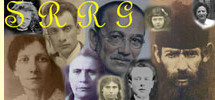Adolph began traveling to different cities for employment-Cleveland, New York, Cincinnati, and Covington, Ky. In New York he stayed with his cousin Max Blitzer, designer of women's suits and coats. Max won the Irish Sweepstakes during the Depression and rather than use the money for his family, chose to return to his childhood hometown, Mielnitza, now Poland (restored to a country in 1919). He visited his family, and was appalled to find how different and difficult life had become for the Jews under the Poles compared to his childhood when it was ruled by emperor Franz Joseph of Austria. Max's daughter, Ida Blitzer Kramer (c 1916-2002) told me that during the 1930s she would mail packages to the families in Mielnitza who wrote to them about their difficult living conditions.
Poland was suffering an economic depression too and anti-Semitism was rampant, even in the schools. My 4th or 5th cousin, Julius Reiter (1914-1996) growing up in Mielnitza told me that in order for a Jewish child to attend school, the parents would have to pay for a Polish child as well. Harassment from students and their teachers was a daily happening for Jewish children. Julius mentioned he thought the 1905 Tailor Shop picture I sent him, with its 2 Austrian Singer sewing machines, was taken in America. He thought Fischel sent it to the family to show how prosperous he was in the new land. Julius' parents, both tailors, had to sew everything by hand as did others in the trade.
The Shoah begins: concentration camps
Across the ocean things were changing. Four concentration camps opened in the early 1930s:
"Dachau (opened March 22, 1933), Sachenhousen, Sachsenburg, and Esterwegen.(7) But none was originally a Jewish extermination camp.[They were intended to intern the {enemies} and critics of the 3rd Reich including homosexuals, political enemies, gypsies, socialists, mentally ills, and, of course, Jews.](8)
Viewing two worlds
Our family history widens now to include the view of two worlds: (1) our family in Toledo, Ohio and (2) the small bits of information I gathered regarding the happenings of the European Jews during this period. My parents and their extended families probably received letters or were kept informed by their cousins, Max and Jake Blitzer who lived in New York. But, Frankie and I, the youngest, were too young to notice any signs of concern my parents might have had. Our older siblings were never told anything directly that they could recall and most likely our parents kept the news to themselves.
|




